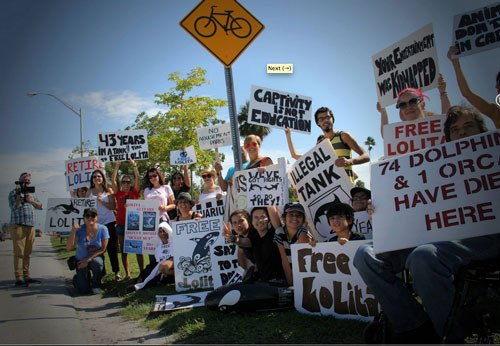By Emily Greenberg
Journal reporter
After over a year of deliberation, the National Marine Fisheries Service has decided to include Lolita in the Endangered Species Act listing of the Southern Resident killer whales.
While welcome news for advocates of the orca whale that’s been living in captivity for more than forty years, the new status does not impact its residence at Miami’s Seaquarium.
“The Endangered Species Act doesn’t prohibit the keeping of captive animals,” said Fisheries Service Spokesman Michael Milstein. “This was not a decision on releasing Lolita. There’s no mechanism to enforce her removal.”
The listing was announced Feb. 6, and will go into effect in 90 days. Though the designation does not mandate her release, it does protect Lolita from “harm and harassment,” as provided by the ESA.
The initial petition to include the captive orca under the ESA was put forth by People for Ethical Treatment of Animals. PETA Attorney Jared Goodman disputes NMFS’ stand on Lolita’s release.
“The decision doesn’t affect her residence because it appears the agency will not actively enforce the Endangered Species Act once Lolita’s listing goes into effect,” Goodman said.
The decision to include Lolita under the ESA listing is a victory for whale advocates in itself, because citizens now have a right to file lawsuits on the orca’s behalf.
If NMFS proves unwilling to return Lolita to her native Washington waters, Goodman said a civil lawsuit could be made to prove that Lolita’s current state of captivity is a violation of the ESA. Whether PETA will file such a suit is not yet known.
In the meantime, a PETA lawsuit against the United States Department of Agriculture is on appeal. The USDA is responsible for enforcing the Animal Welfare Act, which PETA says Seaquarium is in violation of on three counts: the small size of Lolita’s tank, the lack of protection from the Miami sun, and the absence of an orca companion.
If established in court that Seaquarium is in violation of the Animal Welfare Act, harm done to the animal by these violations will also be recognized, and the ESA may be in violation if Lolita is continued to be kept in the same condition.
Although Lolita’s new status may put more power into the hands of whale advocates, NMFS remains as the keeper of the gate. In a press release dated Feb. 4, the federal agency announced that any future plan to move or release Lolita would require a permit and would undergo “rigorous scientific review,” before being issued.
“Between Seaquarium and the government this could go on for some time,” said Ken Belcomb, director of the Center for Whale Research. “If they drag it out forever and she passes along the way, her carcass is also protected. That’s of great scientific value.”
There’s a relocation plan set up and ready to go if Lolita is returned to her native Pacific Northwest waters. Developed by Orca Network and the Center for Whale Research, it includes a protected sea pen within a cove in the Salish Sea where the orca can re-acclimate to life in the wild.
According to Orca Network, the whale would be provided with all the care and companionship she experiences now, and in time would have the opportunity to swim distances in the San Juans, communicate with and eventually be reunited with her long last family.
The release of Keiko, the captive killer whale known for his role in the movie “Free Willy,” is a source of contention for many who question Lolita’s safety if she were to be released in the Salish Sea. Keiko was released to his native Iceland waters and died five years later. But Balcomb said very little was done to locate Keiko’s family, which played a role in his fate.
“There’s no doubt where Lolita came from,” he said.
Lolita is a member of L-pod.
Orca calls have been picked up on the Lime Kiln hydrophone from as far as Port Angeles, a distance of about 20 miles. Orca Network’s Howard Garrett estimates that when L-pod comes up around Discovery Island and Haro Strait, Lolita would hear their calls and answer.



